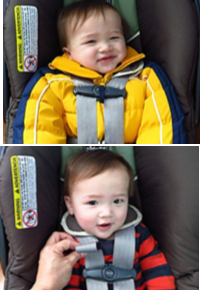Keeping Children Warm and Safe Through Winter
The car seat harness provides the best protection when correctly placed on the child and tightened snugly. The harness keeps the child in the car seat and spreads the crash forces over a large area of the body reducing the risk of injury. As cooler weather approaches, parents will bundle children in bulky coats to keep them warm, but a bulky coat will make it difficult to adjust the harness to fit the child correctly. Bulky coats can compress in a crash and create slack in the harness, increasing the risk of injury. Extra slack in the harness can be very dangerous; it can lead to too much forward movement or even ejection during a crash.
To determine if the child’s coat is too bulky and not safe to use under the harness while traveling in the car:

- Put the coat on the child and correctly place the car seat harness on the child’s body. Secure the harness and adjust snugly to fit the child. A snug harness does not allow the webbing to be folded between your thumb and forefinger when pinched at the shoulder.
- Without loosening the harness, unbuckle and remove the child from the car seat.
- Remove the coat and place the child back in the car seat. Correctly place the harness on the child’s body and buckle the harness straps. If you can pinch the webbing between your thumb and forefinger, the coat is too bulky to be worn under the harness.
What you CAN Do to keep children warm in the car:
- Purchase coats that provide warmth with thinner fabrics and fillers.
- Place a blanket over the child after the harness is snug and secure. Never place blankets or products sold to keep a child warm between the harness and the child.
- Put the child’s coat on backwards once the harness is buckled and tightened.
- Secure the child in the car seat with the clothes that will be worn while indoors.
- Buckle and tighten the harness snugly. A snug harness does not allow any slack. It lies in a relatively straight line without pressing on the child’s body and pushing it into an unnatural position. The harness should be snug enough on the child that you cannot pinch any extra webbing.
- Slip the child’s arms through the sleeves to wear the coat backwards and over the snug harness.
- In the event of a crash, the snug harness will keep the child secure.
- Warm up the car in a well-ventilated area prior to taking the child outside.
Secure Children Correctly in the Car Seat
- Properly position the harness on the child.
- Rear-facing: The harness straps should lie flat and be threaded through the slot that is at or below your child’s shoulders.
- Forward-facing: The harness straps should lie flat and be threaded through the reinforced slot that is at or above your child’s shoulders.
- Buckle the harness and tighten the harness until it is snug on the child.
- Make sure the chest clip on the harness is at armpit level.
Always Follow the Car Seat Manufacturer’s Instructions
- Install the child’s car seat correctly. Read and follow the car seat instructions and the vehicle owner’s manual carefully to achieve a correct installation. Useful tips to obtain a correct installation:
- Read the car seat instruction manual and the portion of your vehicle owner’s manual covering car seat installation.
- Place the car seat in a back seat of the vehicle and secure it tightly. It should not move side-to-side or front-to-back more than 1-inch when pulled at the belt path.
